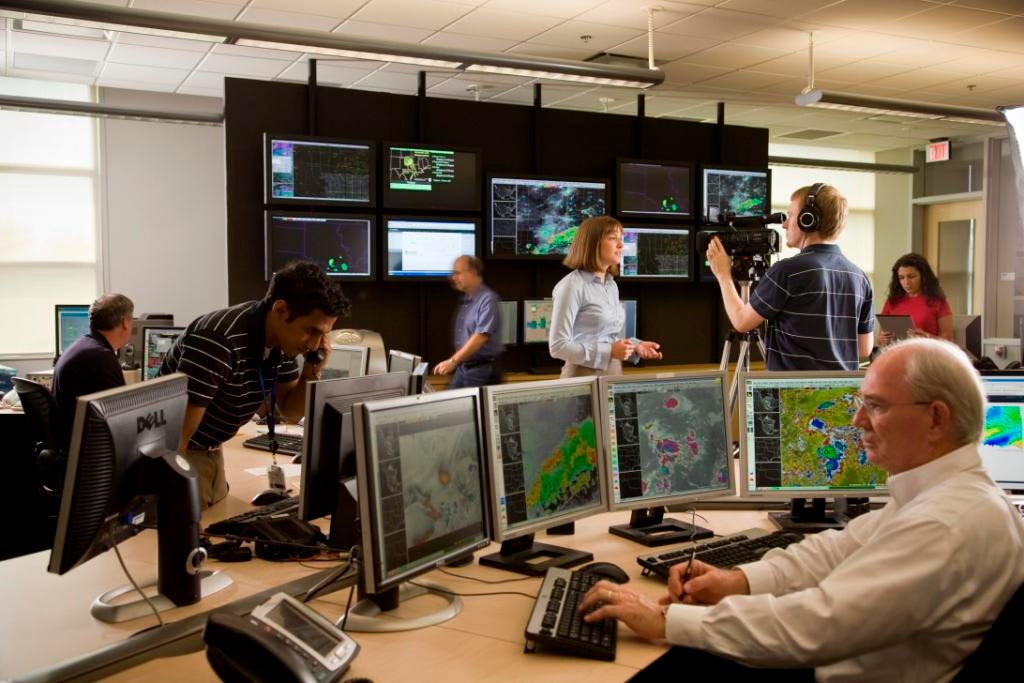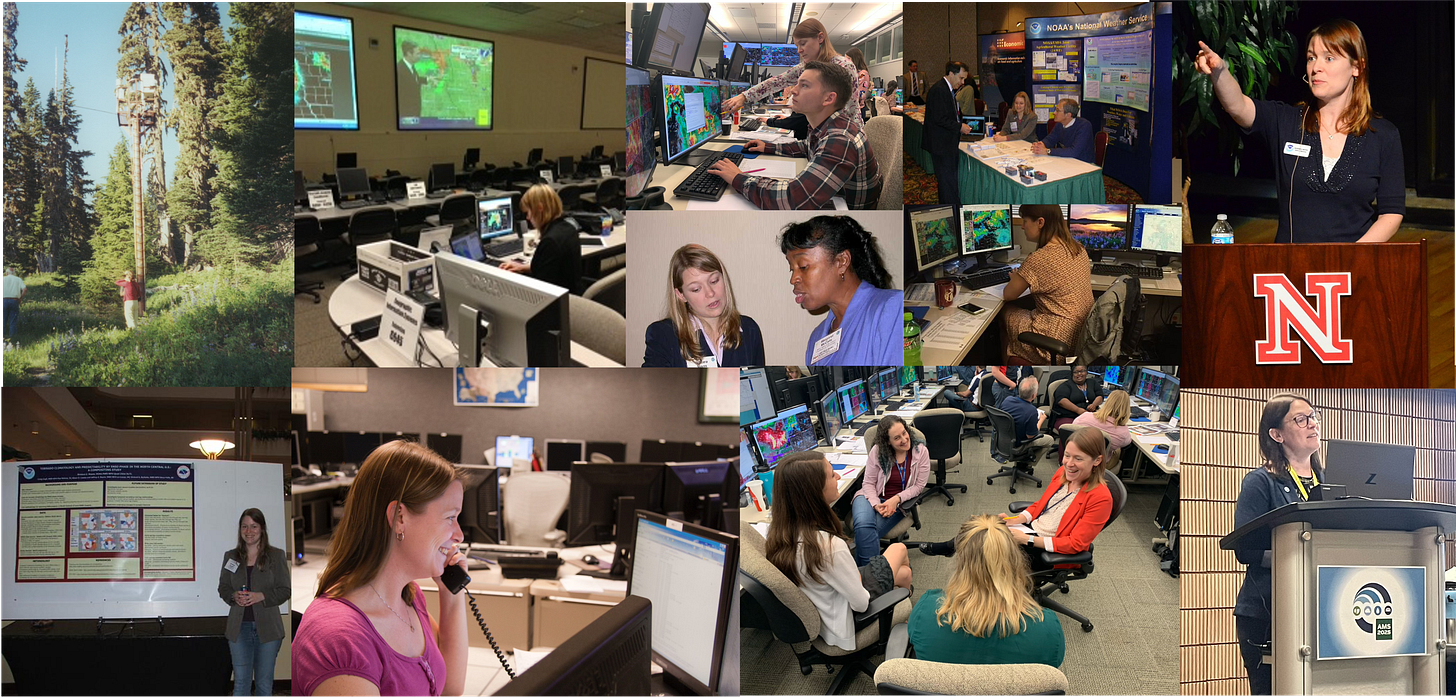What Do Meteorologists Do?
Part 1: Weather careers in federal government
If I ask you to picture a meteorologist, what do you imagine?
Of course, meteorologists can do all of the above and more! They also write documents and reports, conduct research using those computer models and observations, and sit in front of multiple computer screens to pull together enough information for a forecast, to name just a very few things.
Meteorologists work for the federal government (especially, but not exclusively, the National Weather Service), universities (both doing research and teaching the next generation of meteorologists), TV stations and digital media, private companies, solo contracting and LLCs, and non-profit organizations. Many of the meteorologists in universities, non-profit organizations, and private companies are funded in part or whole by federal government contracts and grants.
Consider this a Part 1 of learning what meteorologists do, focusing on those who work for the federal government. In a future newsletter, I’ll cover some of the other roles meteorologists take in the public sector (business and industry), universities, and non-profit organizations.
National Weather Service (NWS)
I’ll have the most to say about the National Weather Service (NWS), which sits in the National Oceanic and Atmospheric Administration (NOAA) under the Department of Commerce, since I can speak from firsthand experience. Most of NWS’s meteorologists are forecasters, assigned to one of 122 Weather Forecast Offices around the country (including Puerto Rico, Guam, and American Samoa). Each office is open 24/7/365, meaning that forecasters work every day of the year and at all hours of the day and night. They miss holidays with their families and suffer rotating shift schedules.
Why do they do it? Because they feel drawn to serve NWS’s mission to “protect lives and property and enhance the Nation’s economy,” words that NWS meteorologists know by and take to heart. Salaries are modest and middle-class - just enough to get by at the start, and comfortable but not wealthy by late career.
A meteorologist’s shift includes assessing observations of ongoing weather and weather patterns, examining computer model output for weather to come, using software to produce a forecast, creating communications packages and conducting briefings to convey the forecast to key partners (such as emergency managers and schools), and taking observations. On quiet weather days, a forecaster will have time for extra duties like outreach, research, or supporting the office in one of many focus areas (for example, creating training for severe weather, coding new tools to support forecast production, or helping their fellow forecasters interpret seasonal outlooks).
On busy weather days (thunderstorms, hurricanes, big winter storms, floods - just to name a few), the normal staff of roughly 2-3 forecasters swells to anywhere from an extra person to literally everyone who can come in and help (10-15 forecasters and other support staff). Forecasters give up their time off, work double shifts, suffer quick turnarounds, all in the name of service. For example, if a severe weather outbreak is in the forecast, those additional meteorologists will come in to handle issuing severe thunderstorm and tornado warnings, monitor and warn for flood threats, analyze the atmosphere near storms to determine how they will progress over the next few hours, call key partners to forewarn about impending hazards (such as calling an emergency manager who has a county fair ongoing in their area of responsibility), and handle the added volume of calls and messages coming in with storm reports. NWS meteorologists train hard for those high-impact days, the days when their forecast and warning services can literally mean the difference between life and death.
When you see the crawl on the bottom of your TV screen that says “The National Weather Service has issued a tornado warning for (Your) County,” that comes directly from NWS. By law, NWS is the only entity in the United States allowed to issue public tornado warnings. Their warnings are what cause your cell phones to buzz with Wireless Emergency Alerts (which, by the way, I hope you have activated on your phones, because they are a fast and reliable way to get warnings wherever you are!).
While most of NWS’s meteorologists work in forecast offices, others also work in regional offices, national forecast centers, and headquarters. Their work helps partners understand, use, and respond to weather forecasts and warnings, produce forecasts that require a broad national lens (such as the work at the Storm Prediction Center to issue severe thunderstorm and tornado watches), and support the forecasters with guidance, technology transfer, research infusion to improve techniques, training, and policies to ensure NWS follows rules and laws. NWS meteorologists in the Environmental Modeling Center (EMC) create, improve, and operate intensive weather forecast computer models. These models are used not only by NWS meteorologists, but by meteorologists across all sectors (public and private) and around the world. Your TV meteorologists and weather apps cannot make their forecasts without the models, observations, and forecasts produced by NWS.
While all NWS meteorologists have college degrees in meteorology or atmospheric sciences (same classes, different labels), new forecasters have much to learn before they are able to fully perform all the duties of their jobs. The training plan for new forecasters includes two to three years of specialized training in everything from launching weather balloons to issuing tornado warnings, ensuring a fully capable staff. NWS invests deeply in its new meteorologists to prepare them for all they will face.
There is no fat to cut in NWS. Every job supports the mission of protecting lives and property and enhancing the Nation’s economy. NWS costs just $3-4 per American per year, but it returns $74 for every $1 of investment in its work (source: AMS, with an article summarizing the findings here).

National Oceanic and Atmospheric Administration (NOAA)
NOAA also employs hundreds (thousands?) of meteorologists beyond those in NWS. Many of NOAA’s meteorologists work in research and in weather and ocean/Great Lakes data collection, quality control, archiving, and analysis. Some others work to deliver grants to local communities, businesses, and non-profit organizations to do the work, providing jobs directly in those communities and investing in their strength and resilience.
All of the work I’ve done to look up weather from Laura Ingalls Wilder’s books and life is possible because of the National Centers for Environmental Information (NCEI), housed under the National Environmental Satellite, Data, and Information Service (NESDIS), an equivalent office to NWS under NOAA’s structure. NCEI collects weather observations from all of the networks around the U.S., then does quality control on those observations to ensure they are accurate. They archive those records and provide access to anyone from researchers to insurance companies to other federal agencies. Every bit of weather data is available because of NCEI’s diligence.
Research done within NOAA usually serves one of two purposes: improving forecast operations or helping communities be safer from and more prepared for weather, water, and climate hazards. Much of that research is done in the various labs under the Office of Oceanic and Atmospheric Research (OAR), yet another equivalent office to NWS under NOAA’s structure. Researchers at the National Severe Storms Laboratory, for example, investigate techniques for analyzing radar data to predict tornadoes with more advance notice, develop radar and computer model analysis tools to help those predictions, and conduct field experiments to measure the atmosphere around tornadic and non-tornadic thunderstorms to better understand why some storms produce tornadoes and others don’t.
NOAA even has its own uniformed service branch, the NOAA Commissioned Officer Corps (called “NOAA Corps” for short), under NOAA’s Office of Marine and Aviation Operations (OMAO). Their personnel operate fish and ocean research vessels, fly the renowned Hurricane Hunter aircraft to understand hurricane threats, chart the seafloor for safe navigation, and assist with disaster response.
Military and Other Federal Agencies
Several other federal agencies employ meteorologists, or meteorology-adjacent folks such as hydrologists and climatologists, to conduct their work. These include the U.S. Department of Agriculture (USDA), the Federal Emergency Management Agency (FEMA), the U.S. Department of Energy, the U.S. Department of the Interior (including the U.S. Fish and Wildlife Service, which is the hub for wildfire management, and the U.S. Geological Survey, which is key in understanding river flows before, during, and after floods), the White House Office of Science and Technology Policy (OSTP), the National Aeronautics and Space Administration (NASA), and the Federal Aviation Administration (FAA), just to name a few.
Meteorologists across federal agencies help those agencies achieve their missions. A USDA meteorologist might help communicate weather outlooks to farmers. NASA meteorologists, among other things, research using satellite data to better understand the Earth’s atmosphere. FEMA meteorologists coordinate before, during, and after weather disasters.
Each military branch also employs meteorologists, including both military (enlisted and officers) and civil staff. The U.S. Air Force and the U.S. Navy both offer meteorology in their academies to train their personnel for weather hazards specific to their missions. Their responsibilities include forecasting for sensitive military operations in all parts of the world, creating and improving computer models to support their forecasts, taking weather observations in areas of military activity to ensure safe operations, and briefing their superiors of weather hazards. Veterans often transition into meteorology roles in other federal agencies after they have completed their military service.
And that’s just federal service!
Meteorologists in federal government are a substantial chunk of the weather community, but they are not the only ones doing weather as a profession. We’ll talk about the others in the weather community soon. In the meantime, please thank your local NWS meteorologists and all of those working in weather, water, and climate across federal government! They work hard, dedicate their lives to service, and expect no glory in return. They just want to keep doing their work to keep you, your loved ones, and your communities safe.
What questions do you have about what meteorologists do, especially those in federal civil service? Ask me anything!
This Month in Wilder Weather History
February 28, 1881: In The Long Winter, Laura Ingalls Wilder implied that the weather was bitterly cold all the way until March. In reality, temperatures nudged above freezing a few times in February of 1881, even reaching the 40s and 50s on a couple of days. Weather records from Minneapolis/St. Paul and from military “frontier fort” sites in eastern Dakota Territory (now eastern South Dakota) confirm those milder temperatures on several days in February at each location. Temperatures would have been mild enough to met at least a little snow on those days. Low temperatures, however, dropped well below freezing every night, and whatever had melted would have developed an icy crust overnight.



This is so important. Thank you for sharing this glimpse into the real world of government meteorologists and scientists.